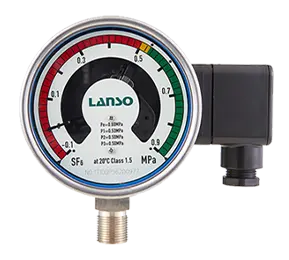Working Principle of SF6 Gas Density Transmitter
The SF6 gas density transmitter is a device used for precisely measuring the gas density of sulfur hexafluoride (SF6) within a sealed container. Its core function is to collect the gas's temperature and pressure parameters in real time, process them through an internal algorithm, and then convert the data into standard electrical signals for remote display, data logging, and automated control.
The working principle of this transmitter is based on the ideal gas law (PV = nRT), with the key focus on eliminating temperature interference from pressure measurements using temperature compensation technology, thereby accurately reflecting the true density of the gas. Specifically:
Relationship between Temperature and Pressure: In a sealed container with a fixed volume, the pressure of SF6 gas fluctuates with temperature changes (due to thermal expansion and contraction). However, the density is determined solely by the gas mass and volume. The transmitter has an in-built temperature sensor that monitors the environment's temperature in real time. It combines this data with the pressure sensor's measured values and uses the ideal gas law to calculate the equivalent pressure at 20°C (i.e., density), thus avoiding misjudgment caused by temperature variations.
Signal Conversion Mechanism: Through the temperature compensation algorithm, the actual measured pressure at the current temperature is converted into the equivalent pressure at 20°C (at which pressure is linearly related to density). This density-equivalent value is then converted into a standard electrical signal, such as a 4-20mA current signal or RS485 digital signal, for external system collection and analysis.
The advantage of this measurement method is that, regardless of environmental temperature changes, the transmitter always outputs the pressure value at the 20°C reference temperature (i.e., the density value). This ensures high-precision measurements, fast response times, and long-term stability, making it widely used in scenarios with stringent density accuracy requirements, such as power equipment condition monitoring and industrial gas leakage early warning.
Setting Method for SF6 Gas Density Transmitter
Installation Location Selection
When installing the SF6 gas density transmitter, it should be placed in an area that is away from vibration and interference sources to ensure the accuracy of the measurement results. Additionally, to prevent temperature from affecting the measurement, the transmitter should be installed in a relatively stable temperature environment. If installed outdoors, a rainproof cover should be provided.
Range Setting
Select the range of the SF6 gas density transmitter according to the maximum and minimum density of the measured medium. Ensure the range can cover the entire density variation range of the measured gas to guarantee accurate measurements.
Regular Maintenance and Calibration
To ensure the long-term stable operation of the SF6 gas density transmitter, regular maintenance and calibration are required. This includes cleaning the sensors, inspecting and tightening the connection parts, and so on. Periodic calibration ensures the accuracy of measurement results.
In the power industry and industrial production, the SF6 gas density transmitter plays a crucial role due to its precise density monitoring capabilities. Understanding its working principle and parameter settings helps with proper selection and optimization of applications, improving equipment reliability and production efficiency. Proper installation, parameter configuration, and periodic maintenance are the core aspects that ensure the continuous and stable operation of the transmitter and the reliability of the data.







